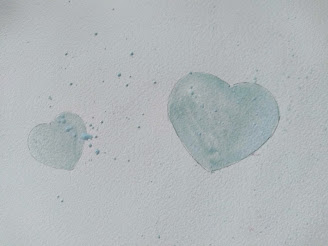USING MASKING FLUID.
Miskit (or masking fluid or liquid friskit or Pebeo) is a liquid that dries to a rubbery solid that can be removed from your paper after painting. It is used to mask off anything you want to remain white. It can be spattered to create a snow effect.
Miskit comes in white, gray, or other color. Many like to use tinted so that they can see where it is to remove it all. They all work equally well.
Do not shake the bottle. You can apply it with a small brush, silicon tip, twigs,skewer, etc. Use only a brush that will not be used for watercolor. Wet the brush, rub a little soap on it. This will help keep it from gumming up. Pour your miskit into a small container and replace the cap on the bottle (or it will gum up and dry too soon). Dip the brush into the miskit and brush it over the area you want to stay white.
Occasionally resoap the brush to keep it clean while you work.
Dry it completely. Do not use a hair dryer (except on cool) or the miskit will become glued to the paper. Wash your brush as soon as you are finished.
The paint and paper must be completely dry before you remove the miskit. You can use a rubber cement square eraser or your fingers to pull it off.
NEGATIVE PAINTING--ONE METHOD OF UNDERSTANDING IT
Here are a few simple examples of negative painting. Most paintings are not completely negative painted, but it is a useful tool in drawing and painting, so having a basic understanding of it is helpful.
This can be done starting with a colorful background or plain. You do not have to use miskit, but I've included it because I want the class to have practice with masking fluid.
USE A SIMPLE PATTERN OR STENCIL. DRAW ONE OR TWO SHAPES AND FILL WITH MASKING FLUID. SPATTER SOME MASKING FLUID IF YOU WISH. DRY COMPLETELY.
This project is simpler if you just use one color and get darker each time. But I did a wash of yellow on the left, red in the middle, blue on the right. Dry completely.
Draw some more shapes, different sizes, and paint the second layer around them, a value or two darker than the first.
More shapes, overlapping and another layer of color.When you paint around the POSITIVE shape, you are painting the NEGATIVE.
Final shapes, final layer of color, using blue. Paint AROUND the positive shapes. The positive shapes appear because you are painting darker behind
Removing masking fluid.
Adding a little shading and detail.
Here's one using some fish patterns. Same steps. Draw a shape, mask it off.
When dry, paint a layer over it and dry it.
Add some more shapes and paint another value over it. Do this as many times as you want. Use a dark value for the last wash.
Remove masking and add details.














